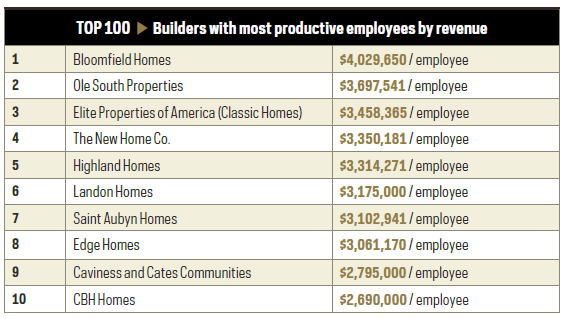Challenges such as labor and land shortages, government regulations, and competition from multiple builders are on the minds of all of the country’s top 200 builders, and many are finding creative ways to overcome them.
Strong subcontractor relationships have helped Saint Aubyn Homes weather labor shortages. “My construction team has done an excellent job fostering a relationship with our trade partners that is truly a win-win arrangement,” says St. Aubyn. “This bond helps secure loyalty when the labor crunches hit.”
The company is also working with suppliers to negotiate price protection moving forward in exchange for long-term commitments. To fuel a strong pipeline of talent, Great Southern has internship and job shadowing programs that help recruit new workers.
Others rely on their strong market positions to get partners on board. “We are a dominant player in a single market, which gives us significant leverage when talking to our local stakeholders,” says Ben Covington, CFO of Orem, Utah–based Edge Homes, which builds primarily entry-level and first-time move-up homes priced from $180,000 to $600,000. The firm, No. 63 on the Builder 100, has grown closings by 55% since 2014.
Such vigorous growth makes it important to know when to put on the brakes, notes Stimple of Classic Homes, which debuted on the top 100 list this year, moving to the No. 100 slot from No. 121 last year. “Our current experienced team is capable of doing 350 to 400 homes without missing a beat so our challenge will be to ensure that any new hires are properly trained, invested in our processes and procedures, and buy in to our overall program.”
Growth is on the mind of New Home Co. executives this year as well, as it opens communities in several new markets. This means learning about zoning and building regulations for many new jurisdictions. “Once we start building and selling homes life is pretty good,” says Webb. “Our challenge is getting to the finish line in terms of starting our new developments.”
The availability of desirable lots near good schools is a perennial problem, too, many builders note. “Regulatory processes imposed by governmental agencies and lack of financing to build new lots have restricted new lot development and keep work constant, Great Southern has an in-house development team that self develops and partners with development companies to keep a steady supply of good lots coming online.
Staying on top of their markets when competing with larger builders is another worry for these small to medium-sized companies. Great Southern manages the construction process from start to finish, says Satterfield, and analyzes sales absorption in order to adjust building levels to match submarket demand. “Managing starts, inventory levels, and cycle times is a big part of our success,” he adds. “We are willing to put product on the ground when others are not.”
Doing More With Less
For the most part, productive firms benefit from their nimble size and limited geographical outreach in ways that builders with regional or national scope cannot. While Classic Homes runs up to 18 projects at once, they are all located within a 20- to 30-minute drive from headquarters. “This factor promotes efficiency,” explains Stimple.
During the downturn, he says, the executive team found ways to do more with less. A web-based scheduling system for in-house employees and trades eliminated significant amounts of paperwork and phone calls. The firm’s construction managers now run houses themselves and oversee other superintendents and allocation of trade partner resources. “Our superintendents are all experienced and require minimal supervision on a daily basis,” Stimple says.
Edge Homes relies on technology to help employees get more done every day. It uses a proprietary scheduling and client communication software system that allows project managers to streamline communications with buyers and update the master schedule for each home. In addition, a web-based portal tracks the status of current and future jobs for trade partners.
Working with the vice president of purchasing and estimating, each member of the company’s management team plays a role in ensuring that the firm is using the best technology available, Covington says. For example, the company developed its own estimating program when executives couldn’t find an out-of-the-box version they liked. He credits this reliance on technology to the company’s young, well-educated workforce. “We believe that being a leader in the use of technology increases our customer satisfaction, improves our relationships with our trade partners, and allows our employees to consistently have a better understanding of their job,” he says.
Perhaps more important than any other quality, prolific builders are in touch with their customers and the communities in which they build. “Even though we have grown at a pace of more than 40% year over year for the past three years, we have kept our brand as a local builder,” says Satterfield.—Charlotte O’Malley contributed to this report



